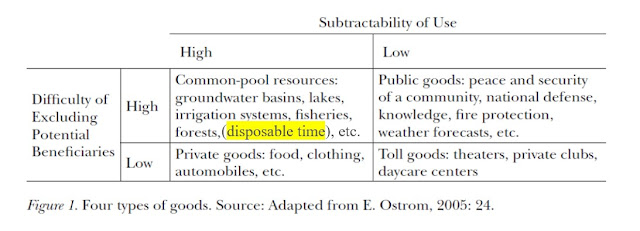Disposable time as a common-pool resource VII — Common-pool property rights Two key features of Ostrom’s analysis: the distinguishing of a spectrum of separable property rights rather than monolithic “ownership” and the use of a grid that classifies goods according to how difficult it is to restrict access to them and the extent to which one person’s use of a good subtracts from what is left available for others. Schlager and Ostrom identified a bundle of property rights pertaining to natural resources that they defined as follows: Access: “The right to enter a defined physical property.”Withdrawal: “The right to obtain the “products” of a resource (e.g., catch fish, appropriate water, etc.).”Management: “The right to regulate internal use
Topics:
Sandwichman considers the following as important: US EConomics, US/Global Economics
This could be interesting, too:
NewDealdemocrat writes JOLTS revisions from Yesterday’s Report
Bill Haskell writes The North American Automobile Industry Waits for Trump and the Gov. to Act
Bill Haskell writes Families Struggle Paying for Child Care While Working
Joel Eissenberg writes Time for Senate Dems to stand up against Trump/Musk
Disposable time as a common-pool resource VII — Common-pool property rights
Two key features of Ostrom’s analysis: the distinguishing of a spectrum of separable property rights rather than monolithic “ownership” and the use of a grid that classifies goods according to how difficult it is to restrict access to them and the extent to which one person’s use of a good subtracts from what is left available for others. Schlager and Ostrom identified a bundle of property rights pertaining to natural resources that they defined as follows:
- Access: “The right to enter a defined physical property.”
- Withdrawal: “The right to obtain the “products” of a resource (e.g., catch fish, appropriate water, etc.).”
- Management: “The right to regulate internal use patterns and transform the resource by making improvements.”
- Exclusion: “The right to determine who will have an access right, and how that right may be transferred.”
- Alienation: “The right to sell or lease either or both of the above collective-choice (management and exclusion) rights.”
The labour-as-a-commodity view actually restricts the scope of the wage earner’s property right to the right to sell all the other rights (alienation!), while a common-pool resource perspective could grant access and withdrawal while retaining the three collective-choice rights.
Ostrom’s matrix of goods is illustrated in the following diagram:

I’ve added “disposable time” to Ostrom’s examples of common-pool resources to reflect Hodgskin’s observation that skilled workers are the product of many years of unpaid care work (“under the strong influence of natural affection and parental love”). It would be extremely difficult to exclude potential beneficiaries from the resulting “good” (skilled labourer). A similar “common-pool resource” designation follows from looking at income employment as the “good” from the perspective of the worker.
